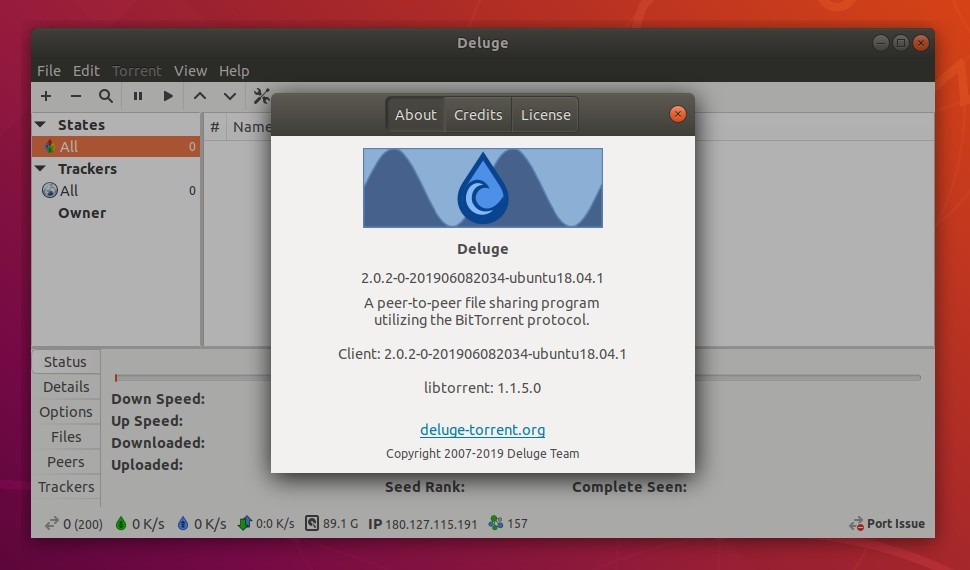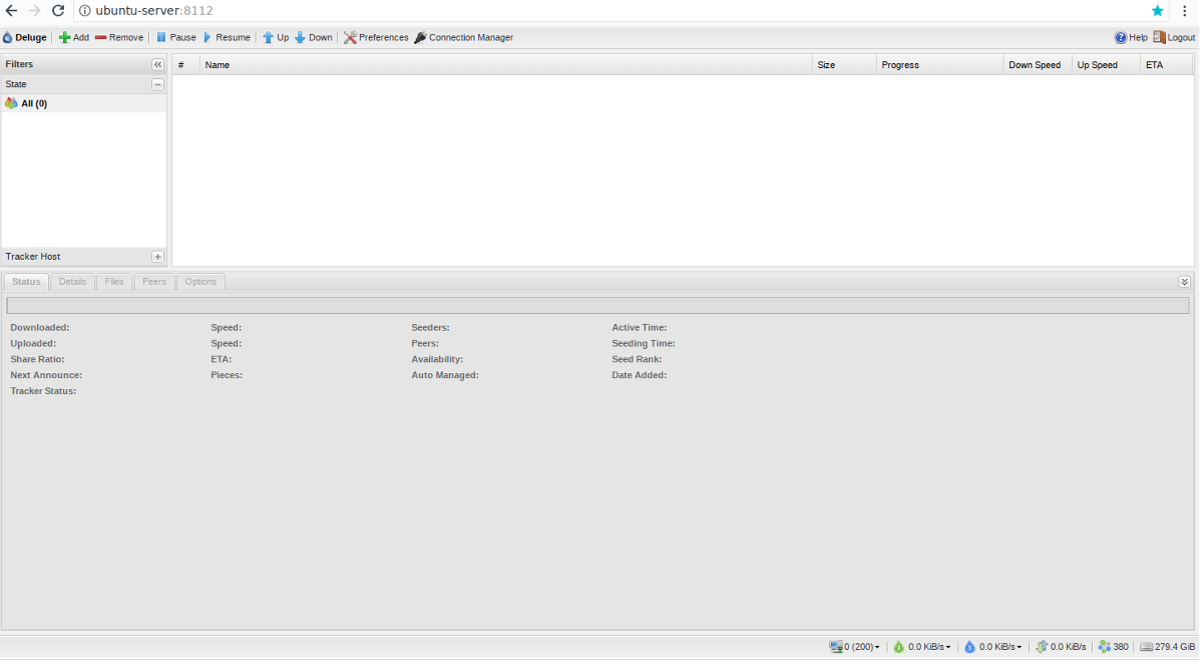
- UBUNTU DELUGE CLIENT HOW TO
- UBUNTU DELUGE CLIENT INSTALL
- UBUNTU DELUGE CLIENT CODE
- UBUNTU DELUGE CLIENT PASSWORD
- UBUNTU DELUGE CLIENT TORRENT
UBUNTU DELUGE CLIENT INSTALL
Install the software from Google Play and open up the application.

There are too many routers and ADSL modems to make detailed explanations here, but you can use the website PortForward for in-depth help. Here you will need to set up a port forward from all external traffic on port number 8112 to you local computers’ IP address – the one that you just retrieved from the Ubuntu connection manager – on the same port. It will most likely have a NAT tab or settings screen. Now go to your the manager interface of your router or ADSL modem. Note it down or remember it: this is your computer local IP address. You need the number that says ‘IP Address’. If choose ‘Connection Information’ it will give you some statistics about your current computer’s network connection. Right-click on the connections icons in the top panel this is the NetworkManager Applet. First get your Ubuntu computer’s IP address. You will need to open up the port 8112 and redirect this to your home computer. The next step is very important if you want to use Transdrone to control Deluge from anywhere you go and not just your home Wi-Fi network. Install the app Transdroid from Google play. Now it is interesting to manage the torrents from your Android. Reboot the raspberry and look if you can login from tour deluge thin client. Sudo -u pi /usr/bin/python /usr/bin/deluged # In order to enable or disable this script just change the execution # Make sure that the script will "exit 0" on success or any other # This script is executed at the end of each multiuser runlevel. Now we want deluge to autostart op the PIĮdit the rc.local to add a line in order to start deluged with user "pi": Now we’re going to turn right around and plug these four new directories into Deluge: Sudo mkdir /media/pi/usbdrive/torrent-backups Use the following commands to create the folder set
UBUNTU DELUGE CLIENT TORRENT
This way we can easily access our downloaded torrents over the network and have a network accessible watch folder for auto-loading torrent files. That little SD card is going to fill up real fast, however, so we need to change it.įirst, we’re going to create some new folders in /media/pi/usbdrive/ By default Deluge directs everything to /home/pi. Now all we need to do is change the default locations in Deluge.
UBUNTU DELUGE CLIENT HOW TO
By following along with the hard drive mounting instructions in How to Turn a Raspberry Pi into a Low-Power Network Storage Device, you’re ready with a hard drive set to auto-mount on boot. Our next step is to configure Deluge to use our external hard drive. torrent in site, but our connection between the remote machine and the desktop client is a success! Click Add.īack in the Connection Manager, you’ll see the entry for the Raspberry Pi (in my case PI and my pwd) if all goes well, the indicator light will turn green.Ĭlick Connect and you’ll be kicked into the interface, connected to the remote machine:
UBUNTU DELUGE CLIENT PASSWORD
You’ll need to input the IP address of the Raspberry Pi on your network, as well as the username and password you set during the earlier configuration. Click the Add button in the Connection Manger and plug in your Pi’s info like so: Here is where you input the information about your Raspberry Pi and the Deluge installation. This time when Deluge starts, it will present you with the Connection Manager. Ĭlick OK and then restart the Deluge desktop client. Within the interface submenu, you’ll see a check box for “Classic Mode”. Once launched, navigate to Preferences -> Interface. Once you have installed the Deluge desktop client, run it for the first time we need to make some quick changes. Hit up the Deluge Downloads page and select the installer for your operating system. We need to install the Deluge desktop client in order to finish the configuration. Now it’s time to kill the daemon and restart it one more time so that the config changes take effect:Īt this point your deluge daemon is ready for remote access.


This enables remote connections to your Deluge daemon and double checks that the config variable has been set. Once you’re inside the console, we need to make a quick configuration change.
UBUNTU DELUGE CLIENT CODE
If starting the console gives you an error code instead of nice cleanly formatted console interface type “exit” and then make sure you’ve started up the daemon. Once you’ve saved them, start up the daemon again and then the console: For our purposes, we used pi:raspberry:10.When you’re done editing, hit CTRL+X and save your changes. Where in user is the username you want for Deluge, password is the password you want, and the level is 10 (the full-access/administrative level for the daemon). Once inside nano, you’ll need to add a line to the bottom of the configuration file with the following convention: Sudo apt-get install deluged deluge-console deluge-webĬp ~/.config/deluge/auth ~/.config/deluge/auth.old


 0 kommentar(er)
0 kommentar(er)
